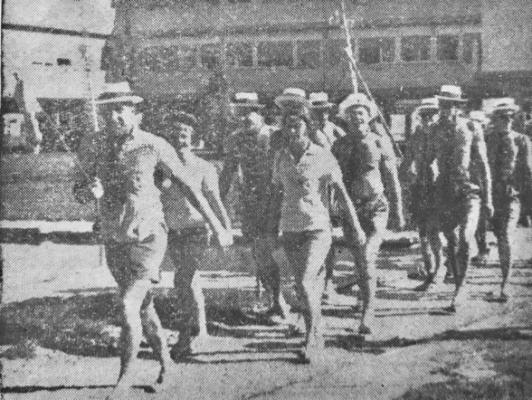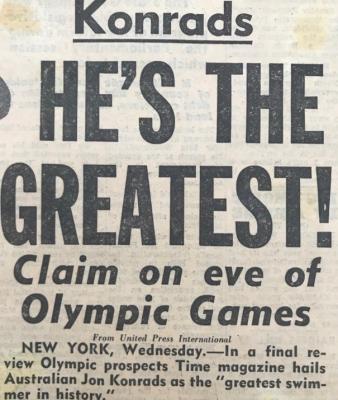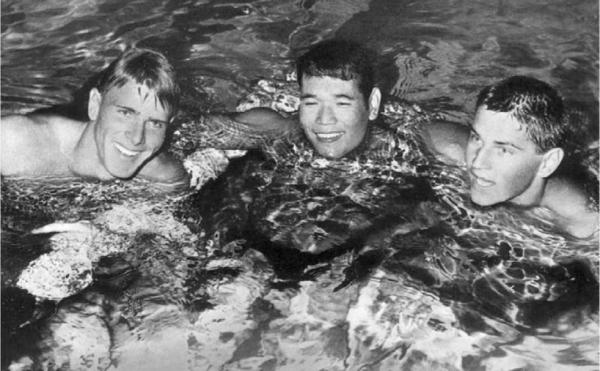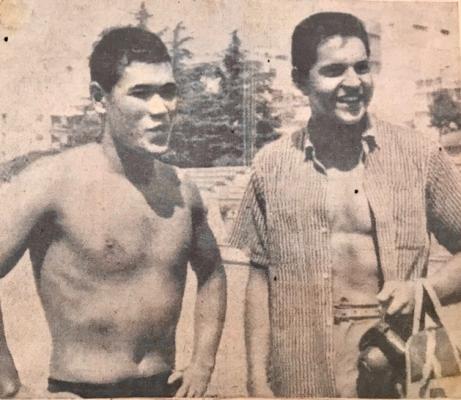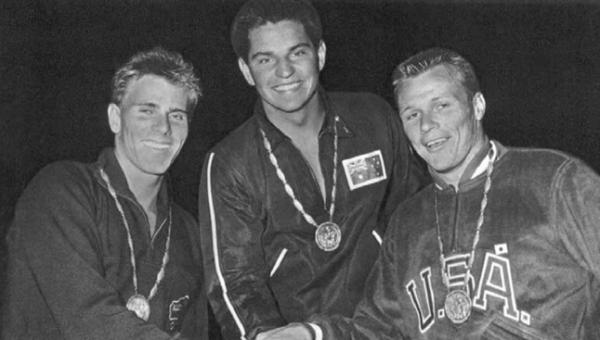The Games of the XXXII Olympiad should have been held this year in Tokyo but as we all know have been deferred until July 2021. However, this year is the 6h Anniversary of the 1960 Rome Olympics, which is significant for several Olympians closely associated with the Noosa Region. Over the next few weeks, Noosa Today will feature stories about those Olympians.
The first Olympian, Noosa resident John Konrads, also provides a close link with Japan because of a friendship which began when he was selected at the age of 14 in the Australian Swimming Team for 1956 Melbourne Olympics. Although he did not get to swim at those Games, John met Tyusoshi Yamanaka, who came second to Murray Rose in both the 400m and 1500m Freestyle.
John and his sister Ilsa became widely known as ‘the Konrads Kids’ over the next few years as they broke world records over a wide range of distances under their coach Don Talbot. In January 1958 in Sydney, John broke world records in the 200m, 220yd, 400m, 440yd, 800m and 800yd – six in eight days. He set another eight in February and March, including a 1500m and 1650yd Freestyle events.
Konrads and Yamanaka were able to renew their friendship, and begin their rivalry, when they competed against each other again in Japan after John had ‘scooped the pool’ at the 1958 Cardiff British Empire and Commonwealth Games. In an interview John said: “After beating him in Tokyo, we went to Osaka and the world’s biggest swim stadium of all time with 25,000 seats. The atmosphere was electric. Spectators all wore white shirts; no women of course. I won the 400 and 1500 and he won the 200, in a new World Record. The crowd went wild”.
When the Australians were in Townsville for their pre-Olympic preparation for the 1960 Rome Games, Yamanaka telephoned from Japan to speak to John, Murray Rose, and other swimmers, to “exchange news and wish his rivals good luck”. Yamanaka informed John that two days before he had clocked 17:21 for the 1500 metres in a time-trial. This was 10 seconds slower than John’s world record.
“Don Talbot arrived in Rome and stayed in a small flat. I was jet lagged but also excited by Rome so Don took me on the back of his Vespa for a tour of the monuments which settled me down,” John said.
As the swimming program at the 1960 Rome Olympics commenced immediately after the Opening Ceremony, the Australian officials would not allow the swimmers to march in to the Stadium. One did march – but that will be a part of a later story. However, John was part of an unofficial ‘Opening Ceremony’ staged at the Athlete’s Village. The Australian male Olympians, dressed in shorts and ties without shirts, and the females in shorts and blouses, brandished ‘flags’ – their swimming costumes tied to the top of sticks. They then marched in a straggling group behind the official Australian team as they boarded buses to the Olympic Stadium.
The three favourites for both the 400m and 1500m Freestyle events were Konrads, Yamanaka, and Murray Rose, the 1956 Olympic champion. Konrads was breaking records regularly, and there was much pressure on this 18-year-old. Time Magazine added pressure when they hailed the contenders for the 400m Freestyle, the first of John’s Olympic events, as “one of the hottest fields in Olympic history”. Murray Rose swam a brilliant race to win becoming the greatest swimmer in history.
Konrads was gracious in defeat. “The better man on the night won – it couldn’t happen to a nicer bloke”. Talbot just told him: “Tough luck mate. Now for the 1500 on Friday night. Yamanaka will go out fast and be way ahead at the 800 (yes, 25m) Murray will save a bit for the last 100 and will catch up to you (he did, up to my shoulders). What great insight from a 29 year-old-coach, who became one of the greatest coaches of all time”.
On the night of September 2, John swam a sensational and well-judged race to win the 1500m Freestyle in 17:19.6. He broke Murray Rose’s 1956 Olympic record by 39.3 sec and was just 8.6 sec outside his own world record. John’s sister Ilsa, who was awaiting the start of the Women’s Relay, burst into tears. She started a chain reaction and within minutes half the women’s team were crying and cheering him.
In his 1994 book, Australia and the Olympic Games, Harry Gordon wrote that John received the greatest ovation of any swimmer at the Rome Olympics and as he mounted the victory dais after winning the 1500m in Olympic record time, “the 20,000 spectators exploded into a mighty burst of cheer and cooees… Even the Romans were calling ‘cooee’”.
Don Talbot acknowledged in his book, Nothing but the Best, that John “swam a strong tactical race, sitting behind Breen before taking the lead at the 1100-metre turn. The hard-chasing Rose was always within three seconds of him, but John toughed it out and held him off to win”.
This was both John’s and Talbot’s first Olympic Gold medal as swimmer and coach. Mike Colman revealed in , 1500 – The Story of Australia’s Race that John said it took him 10 years to realise it, but the moment Talbot came up to him after the 400m was the moment he won the 1500m gold medal: “I knew I was going to win before I got up on the blocks. Thanks to Don I focused on myself. Don told me exactly how the race would be swum and what I had to do to win and it all unfolded exactly like he said. He told me Yamanaka would go out early and he did. He told me not to worry about him, that the field would catch him and we did. He told me where George Breen would be at the half way mark. He said he wasn’t sure how Murray would swim but not to be too worried about him because he hadn’t swum too many 1500s for a while. He thought Murray would pace himself off me but felt when it came down to the finish I would be too strong”.
John’s parents had risen at dawn in Cardigan Road, Greenacres in Sydney to hear the live broadcast of the race; his father John said the win was “the best Father’s Day gift I’ve ever had”. Elsa said scores of people telephoned to congratulate them on John’s victory. “Dozens of them were strangers to us,” she said.
John returned to Sydney with more than 100 teammates to be greeted by even more hundreds of the public. He was feted at Sydney’s Mascot Airport. During his many press interviews throughout the 1960 Rome Games John had indicated it was likely he would undertake further studies at a university in the United States, which he did. He competed in the 1964 Tokyo Olympic Games, and after a successful business career in France, Victoria, and Sydney, he now resides in Noosa.


